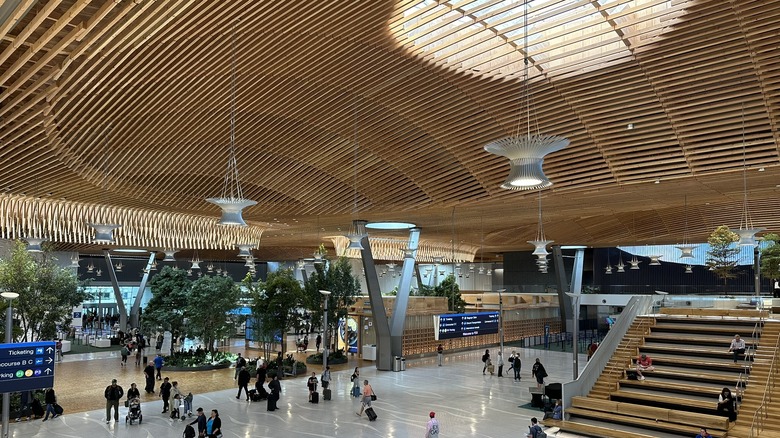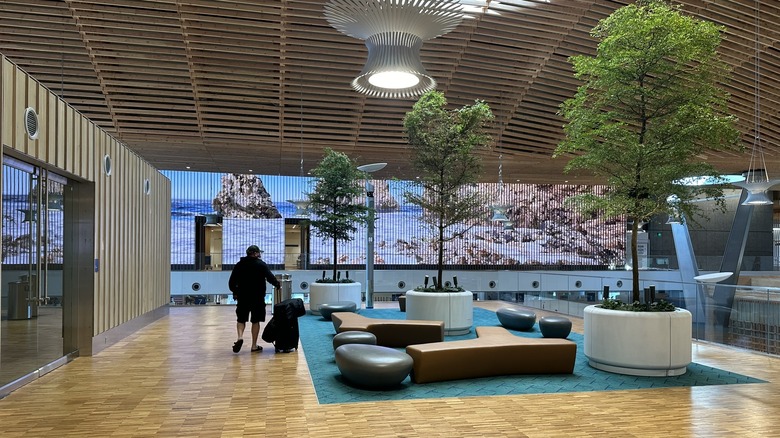With Therapy Animals And A Growing Forest Inside, This US Airport Is Wowing Travelers
Portlandia? Stumptown? Try PDX. Portlanders commonly use the airport code as a fond nickname for their hometown, and now they have a gloriously outdoorsy new airport that truly reflects their city's progressive vibe. The PDX Next terminal used high-tech "gluelam" technology (glue + lamination) for the construction of the beams in its mass-timber ceiling, clad in an undulating, lattice-covered canopy that spans nearly 400,000 square feet.
Below, the wavy, patterned terrazzo floor in shades of gray echoes the cool, foamy waves of the mighty Columbia River, which flows just outside, while islands of trees and teeming ground cover, fed by 49 skylights, evoke the forest. As you stand in line waiting to check in for your flight, you can watch video art play across two 120-foot-long moving canvases, where seasonal scenes from nature complement the indoor landscape in a work titled "Extraordinary Windows," created using video game technology and designed to reflect the weather outside and the foot-traffic inside: On a busy summer day, you may see an equally busy swarm of butterflies flitting around a waterfall, and on a quiet winter weekday, a lonely, serene beach on Oregon's famous coast. Still anxious about flying? Pet one of the resident therapy llamas. Yes, therapy llamas.
Standing in this surreal, sci-fi take on a Pacific Northwest forest, there is no doubt about where you are: This could only exist in Portland, Oregon. This airport is so nice locals come here without any plans to get on a plane, just to hang out. "Exhilarating and drop dead gorgeous would be my spontaneous assessment of the new @pdx terminal," writes one proud local Instagrammer who did just that. "So uplifting and exciting to wander through! The new terminal captures the aura, natural beauty, and history of Oregon and the Pacific NW."
Nature is an architect at Portland International Airport
That naturalistic feeling you get strolling through PDX is a result of a new trend called biophilic design. International architectural firm ZGF Architects has been working with the Port of Portland since its first airport expansion in 1965, and their design for the new terminal focuses on natural materials, daylight, and organic forms. "The use of wood is also very important from a wellness perspective—its warmth positively influences the passenger experience and connects us to the Pacific Northwest," ZGF Managing Partner Sharon van der Meulen said in a statement on the firm's website.
The wood used in the project was harvested within 300 miles of the site, much of it sourced from tribal lands. The mass timber construction method, in which wood is laminated together to form structural beams, is more sustainable than steel or concrete beam construction, as it uses a renewable resource and requires less energy during transport and building phases. It's a technologically advanced building method that's currently more popular in Europe than the U.S., but look for that to change, as the world's tallest mass timber building, a 25-story mixed-use project, has now gone up in Milwaukee, Wisconsin, and high profile projects like Amazon's new HQ2 headquarters in Arlington, Virginia have tapped into this marvelously earth-friendly construction method.
The new terminal is sustainable under the hood, too. It is designed to use 50% less energy per square foot and to meet or exceed LEED Gold Standards for efficiency. But it's the experiential aspect that puts the new PDX on a par with the world's top-ranked airports, all of which serve much bigger cities.
PDX's new terminal is hyper-local
Third-wave coffee and craft beer on tap. Donuts and pasta handmade on site. Farm-to-still cocktails from a woman-owned distillery. All very Portland, but at an airport? PDX has been a pioneer in keeping it local since the 1980s, when local indie darling Powell's Bookstore opened a branch there. Other longtime local vendors include Pendleton and Columbia Sportswear. Newer additions include Tender Loving Empire, an ultra-hip local chain gift shop — and music label — that showcases local makers and musicians. Portland is a legendary foodie destination, and now you can eat at some local hotspots like The Screen Door and Grassa without leaving the airport. The Port of Portland holds airport retailers and restaurants to a strict "street pricing" policy: Businesses must charge the same at the airport as they do at their other local outlets.
Another holdover from the 1980s is the carpet pattern. The garishly distinctive teal carpet that the airport originally installed in 1988 became such a cult sensation that when it was removed a decade ago, collectors snapped up and framed squares of it. NBA All-Star and Portland Trailblazer hero Damian Lillard even designed his signature Adidas shoe based on the pattern. So the new airport had it faithfully reproduced in all its retrowave glory.
True to the city's "Keep Portland weird" motto, one of the terminal's new features is the inclusion of "therapy llamas" to soothe the frayed nerves of travelers. On a weekday afternoon, a blissed out fellow named Max (pictured) is on duty, wandering the terminal with his handler, patiently snorfeling snacks from the palms of beaming, delighted passengers, and smiling Sphinx-like as hands stroke his cloudlike poofs of poodle-cut fur. Doubters take heed: Petting Max does deliver an instantly noticeable dopamine hit. Weird and oh-so-wonderful.


